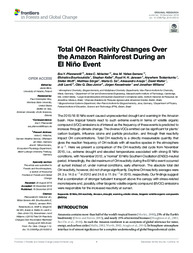Total OH reactivity changes over the Amazon rainforest during an El Niño event.
Total OH reactivity changes over the Amazon rainforest during an El Niño event.
Author(s): PFANNERSTILL, E. Y.; NÖLSCHER, A. C.; YÁÑEZ-SERRANO, A. M.; BOURTSOUKIDIS, E.; KEBEL, S.; JANSSEN, R. H. H.; TSOKANKUNKU, A.; WOLFF, S.; SÖRGEL, M.; SÁ, M. O.; ARAUJO, A. C. de; WALTER, D.; LAVRIC, J.; DIAS-JUNIOR, C. Q.; KESSELMEIER, J.; WILLIAMS, J.
Summary: The 2015/16 El Niño event caused unprecedented drought and warming in the Amazon basin. How tropical forests react to such extreme events in terms of volatile organic compound (VOC) emissions is of interest as the frequency of these events is predicted to increase through climate change. The diverse VOCs emitted can be significant for plants' carbon budgets, influence ozone and particle production, and through their reactivity impact OH concentrations. Total OH reactivity is a directly measureable quantity that gives the reaction frequency of OH radicals with all reactive species in the atmosphere in s?1. Here we present a comparison of the OH reactivity diel cycle from November 2015, i.e., extreme drought and elevated temperatures associated with strong El Niño conditions, with November 2012, a ?normal? El Niño Southern Oscillation (ENSO)-neutral period. Interestingly, the diel maximum of OH reactivity during the El Niño event occurred at sunset instead of, under normal conditions, early afternoon. The absolute total diel OH reactivity, however, did not change significantly. Daytime OH reactivity averages were 24.3 ± 14.5 s?1 in 2012 and 24.6 ± 11.9 s?1 in 2015, respectively. Our findings suggest that a combination of stronger turbulent transport above the canopy with stress-related monoterpene and, possibly, other biogenic volatile organic compound (BVOC) emissions were responsible for the increased reactivity at sunset.
Publication year: 2018
Types of publication: Journal article
Unit: Embrapa Eastern Amazon
Observation
Some of Embrapa's publications are published as ePub files. To read them, use or download one of the following free software options to your computer or mobile device. Android: Google Play Books; IOS: iBooks; Windows and Linux: Calibre.
Access other publications
Access the Agricultural Research Database (BDPA) to consult Embrapa's full library collection and records.
Visit Embrapa Bookstore to purchase books and other publications sold by Embrapa.

